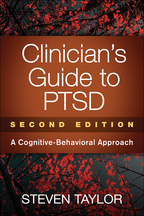Clinician's Guide to PTSD
Second Edition
A Cognitive-Behavioral Approach
Steven Taylor
HardcoverPaperbacke-bookprint + e-book
Hardcover
orderJuly 23, 2017
ISBN 9781462530496
Price: $71.00 372 Pages
Size: 6" x 9"
Paperback
orderJuly 24, 2017
ISBN 9781462530489
Price: $47.00 372 Pages
Size: 6" x 9"
Sign up for emails on upcoming titles on Trauma & PTSD (with special discounts)!
The reproducible materials can be downloaded and printed in PDF format.
The reproducible materials can be downloaded and printed in PDF format.
“A comprehensive, accessible text that will likely appeal to a wide range of clinicians with varying levels of experience....This book is truly a 'Clinician's Guide'....A thorough, hands-on text.”

—Journal of Contemporary Psychotherapy (on the first edition)
“Taylor—a CBT master therapist—has revised and updated his A to Z volume that is a 'must read' for every clinician treating PTSD and every clinical student. Including recent innovations, the book is accessible and features case examples throughout. The book reviews the literature and delves into assessment, case formulation, cognitive interventions, exposure exercises, and, in a new chapter, combining CBT with pharmacotherapy. Even seasoned clinicians will discover new information that will change their practice.”

—Barbara Olasov Rothbaum, PhD, ABPP, Professor of Psychiatry, and Director, Emory Healthcare Veterans Program and Trauma and Anxiety Recovery Program, Emory University School of Medicine
“This second edition is a masterpiece, blending Taylor's long experience and deep understanding of PTSD with many practical recommendations. It provides a clear review of the latest evidence for the benefits and limitations of CBT. The book gives many illustrations of how treatment is delivered, highlighting the importance of taking a flexible approach. Of particular value are the discussions of specific populations—such as children, older adults, and those with substance use problems—as well as the coverage of how other PTSD treatments interface with CBT. I recommend this book to graduate students and professionals alike as an authoritative text, a hands-on guide, and an excellent reference source.”

—Jonathan R. T. Davidson, MB, BS, FRCPsych, Department of Psychiatry and Behavioral Sciences (Emeritus), Duke University Medical Center
“A valuable resource for anyone working with survivors of trauma and PTSD. The second edition synthesizes important advances in diagnosis and treatment. The primary focus is providing practical guidance to clinicians, illustrated through multiple case examples and supplemented with useful clinical tools, including downloadable handouts and worksheets for clients. This book is a gem.”

—Kim T. Mueser, PhD, Department of Occupational Therapy, Department of Psychological and Brain Sciences, and Center for Psychiatric Rehabilitation, Boston University
—Journal of Contemporary Psychotherapy (on the first edition)
“Taylor—a CBT master therapist—has revised and updated his A to Z volume that is a 'must read' for every clinician treating PTSD and every clinical student. Including recent innovations, the book is accessible and features case examples throughout. The book reviews the literature and delves into assessment, case formulation, cognitive interventions, exposure exercises, and, in a new chapter, combining CBT with pharmacotherapy. Even seasoned clinicians will discover new information that will change their practice.”
—Barbara Olasov Rothbaum, PhD, ABPP, Professor of Psychiatry, and Director, Emory Healthcare Veterans Program and Trauma and Anxiety Recovery Program, Emory University School of Medicine
“This second edition is a masterpiece, blending Taylor's long experience and deep understanding of PTSD with many practical recommendations. It provides a clear review of the latest evidence for the benefits and limitations of CBT. The book gives many illustrations of how treatment is delivered, highlighting the importance of taking a flexible approach. Of particular value are the discussions of specific populations—such as children, older adults, and those with substance use problems—as well as the coverage of how other PTSD treatments interface with CBT. I recommend this book to graduate students and professionals alike as an authoritative text, a hands-on guide, and an excellent reference source.”
—Jonathan R. T. Davidson, MB, BS, FRCPsych, Department of Psychiatry and Behavioral Sciences (Emeritus), Duke University Medical Center
“A valuable resource for anyone working with survivors of trauma and PTSD. The second edition synthesizes important advances in diagnosis and treatment. The primary focus is providing practical guidance to clinicians, illustrated through multiple case examples and supplemented with useful clinical tools, including downloadable handouts and worksheets for clients. This book is a gem.”
—Kim T. Mueser, PhD, Department of Occupational Therapy, Department of Psychological and Brain Sciences, and Center for Psychiatric Rehabilitation, Boston University



